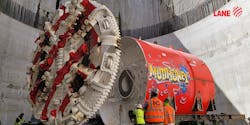The Tunnel Boring Machine (TBM) “MudHoney” was lowered into the ground today in Seattle, Washington, ready to get to work on the Ship Canal Water Quality Project.
The project is a $570 million program, being performed by The Lane Construction Co., the U.S. subsidiary of the Webuild Group. Lane has a $255 million share of the project. When completed the tunnel will prevent, on average, up to 75 million gallons of polluted stormwater and sewage from entering the Lake Washington Ship Canal, Salmon Bay, and Lake Union each year.
According to Pitchfork, the boring machine is named after the late-80s grunge band Mudhoney, who is based in Seattle. Seattle Public Utilities launched an online vote to pick a name for the 900,000-pound drill. Mudhoney emerged the overwhelming winner, with more than 76 percent of the vote. Other finalists included Daphne, and Molly the Mole.
Currently in dry weather conditions, all sewage flows to a local wastewater treatment plant. During wet weather conditions, polluted runoff can exceed the pipes’ capacity and send a mixture of stormwater (90 percent) and sewage (10 percent) to outfalls that flow into the nearest water body. These combined sewer overflows, or CSOs, contain contaminants that can affect public and environmental health. The new 2.7-mile, 18 foot 10 inch diameter tunnel will capture and temporarily hold more than 29.6 million gallons of stormwater and sewage during heavy rains. When the storm passes, flows will be released to the treatment plant. The project is expected to be completed by 2025 and is a joint project between the City of Seattle and King County.
The Ship Canal Water Quality Project adds to Lane’s portfolio of work in the western United States, where it is actively constructing a $705 million highway project (of which Lane has a 40 percent share of) in the City of Bellevue, Washington, and another $400 million roadwork project in San Bernardino, California. Lane also has ongoing tunnel work in Washington, D.C. and Fort Wayne, Indiana, among other complex, multi-sector projects throughout the country.
Source: Land Construction, PitchFork, Seattle Times




